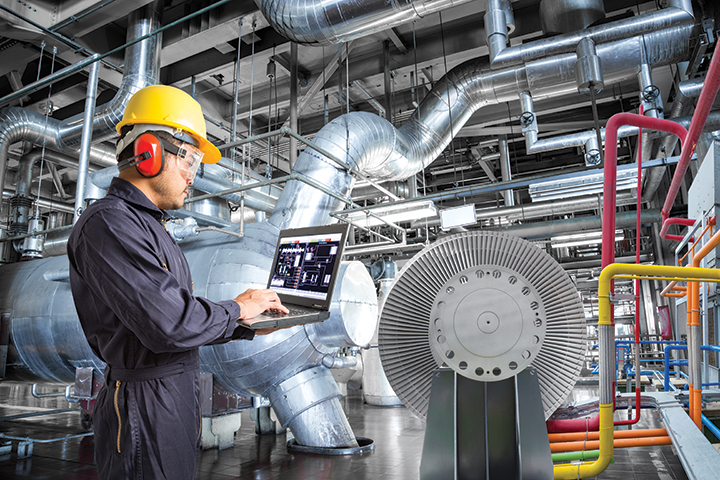
Types of Condition-Based Monitoring
March 10, 2020 | By Peter Philips
 Photo Credit: ipopba / Getty Images
Photo Credit: ipopba / Getty Images Years ago, I wrote a vibration analysis article: It all started with a screwdriver (www.mromagazine.com/features/it-all-started-with-a-screwdriver/). It explained the evolution from using a screwdriver in the 1950s to assess the mechanical health of the Canadian Armed Forces Sea King helicopter and how they moved to early vibration analysis tools for condition-based monitoring
(CBM). Now, many years later, monitoring the health of equipment is a sophisticated process, one that most industries are embracing.

Photo Credit: ipopba / Getty Images
CBM is a type of predictive maintenance that involves using sensors and other measurement tools to measure the status of an asset over time while it is in operation. The data collected can be used to establish trends, predict failures, and calculate remaining life of an asset. Since failures can be detected early and downtime is avoided, CBM can reduce the overall cost per unit of a product.
Unlike preventive maintenance, where maintenance operations are scheduled based on equipment-specific knowledge, statistics, and internal or regulatory requirements. the predictive one relies on monitoring the operational state of the equipment and the evolution to scheduling maintenance based on equipment condition.
Many maintenance staff in process industries have a complex job. They must constantly seek to balance the opposing requirements of maximizing production and machinery uptime while simultaneously minimizing unplanned downtime, while operating within a fixed maintenance budget.
Traditionally, processing plants and non-manufacturing facilities have scheduled maintenance plans for all machines that directly affect production or critical facility systems. However, CBM has proven to be a more effective maintenance strategy when applied to critical equipment and safety-related situations where there is potential danger to the tradesperson performing the machine inspections.
CBM comes in many different applications. The first type of CBM that comes to mind is vibration analysis; however, today and at the onset of Maintenance 4.0, many more options are at our doorstep.
Let’s have a look at what’s available.
Vibration Monitoring
Vibration monitoring is probably the most popular and broadly used type of CBM. This is primarily due to its versatility; most machines regularly produce or experience at least some level of vibration, making this type of device an excellent choice for companies with many different machines to monitor.
Typically, a vibration monitoring device is attached in some manner to the casing or outer part of the machine. As rotating or otherwise moving parts within the machine perform their jobs, vibrations occur,. These vibrations are picked up and catalogued by the monitoring hardware, typically via accelerometer technology. Vibration analysis is the primarily recommended form of CBM for any machine with rotating parts such as pumps, motors, engines, fans, blowers, and many others. In addition, vibration monitoring devices are extremely effective in detecting misalignments of gearboxes and vibrations in many types of bearings such as the pillow box.
Sonic and Ultrasonic Monitoring
If strange vibrations are the No. ! indication that something is potentially wrong with a machine, then strange sounds are certainly No. 2. Worn, broken, damaged, misaligned, or otherwise improperly functioning parts can make any number of odd sounds. These sounds have been described as grinding, screeching, cracking, and creaking. Sonic CBM devices measure and detect these sounds and then provide an alert that the machine should be inspected or maintained.
The signals monitored by an ultrasonic device are expressed as data using the unit decibels per microvolt (dBuV). Since ultrasonic monitoring focuses on both sonic and electrical elements of machinery, it is capable of detecting not only mechanical failures but also electric failures. Ultrasonic monitoring is highly accurate and, like vibration monitoring, is able not only to identify potential failures early but also to narrow down and specifically pinpoint which parts are in danger of failing.
Lubricating Oil Analysis and Quality Monitoring
Many types of equipment and machinery use some type of lubricating oil to keep their parts moving smoothly and prevent harsh rubbing or impacts between small, delicate elements. These oils must be carefully observed due to high risk of failure and are an excellent indicator of the equipment’s overall health. For this reason, devices have been created that analyze the contents and composition of lubrication oils and provide extremely detailed data, usually via software.

Photo Credit: Kinwun / Getty Images
There are currently a number of different oil analysis devices available, as several methods have been developed that are effective in determining the health of the oil. A scanning electron microscope can be used to take a picture of oil samples in order to obtain close-up views of suspended debris or particles.
Spectrographic oil analysis identifies the chemical composition of the oil at various times throughout the monitoring cycle and provide alerts if unusually high amounts of certain elements or metals are present. Wear debris detection sensors utilize similar methods but focus specifically on the detection of metal particles and the relative proportions of ferrous (iron-containing) and non-ferrous metals present in the oil.
Thermographic (Temperature) Monitoring
Temperature is another common indicator that something may be wrong with your machine. Many components, especially moving parts, tend to give off unusual amounts of heat when they degrade. Heat can also be a warning sign that too much friction is occurring, which can be a sign of misalignments or parts rubbing against one another.
Thermographic CBM devices measure variations in temperature across the surface of the machine to detect areas in which unnatural amounts of heat may be being emitted. Since thermographic devices are especially effective at detecting failures related to rotating parts, they are often used in combination with vibration monitoring hardware, especially on larger machines with many small interconnected elements.
Current and Voltage Monitoring
As some of the above-mentioned devices are primarily focused on detecting mechanical failures, additional hardware has been developed, which specifically focuses on electrical failures. These devices typically measure electrical currents running through the machine and test for unusual voltages.
Current and voltage monitoring devices can detect imbalances in the electrical supply situations in which the machine is receiving too much or too little electricity to function properly, or if something has disrupted the flow of electricity or broken or disrupted any circuits. Some current monitors can also detect specific types of mechanical failures, such as bearings or other rotating parts that are beginning to fail.
The CBM devices described above are only the most popular and widely used of the many varieties currently available for use. Practically every parameter, property, or quality of a machine can be monitored and will indicate at least something about its current health and performance. Therefore, it is impossible to list every type of CBM device currently being manufactured or used.
Benefits of CBM
While each type of CBM device possesses its unique advantages, a number of universal benefits come with the implementation of a successful CBM strategy. They are too numerous to list entirely, but frequently include:
• Extended lifespan of machinery, as collecting data can lead to improvements, which decrease the risk of future failures;
• Saving money over time due to not performing maintenance too frequently or having to replace completely destroyed parts due to undetected failure;
• Employees who possess a greater familiarity with and understanding of the machines that they operate;
• Decreased health and safety risks due to failures being prevented before they occur;
• The decrease or complete elimination of both planned and unplanned downtime, as CBM devices can collect the necessary data while the machines are running; and
• An overall more efficient and successful production process due to the elimination of downtime as well as a significantly lowered risk of producing deformed, damaged, or otherwise unusable parts.
CBM offers myriad benefits, providing early warnings of potential serious failures, reduction in unplanned downtime, reduction in maintenance costs, and support of ongoing reliability and risk reduction with fewer inspections at heights, and confined and remote assets. A new breed of low-cost, easily installed CBM systems can provide these benefits without the high upfront cost and inherent complexity of traditional CBM. Gone are the days of the screwdriver, and soon the days of using the human senses of look, touch, smell, and listen to assess equipment will be in the history books as well. MRO
